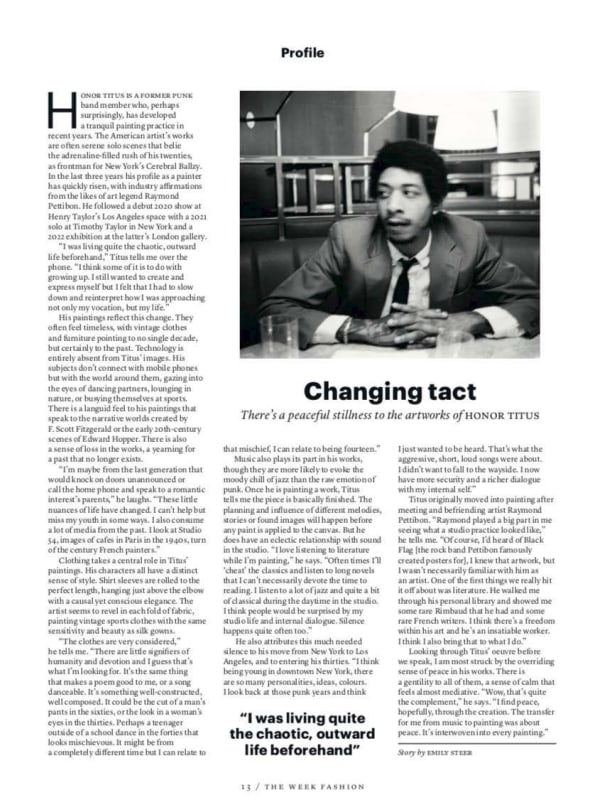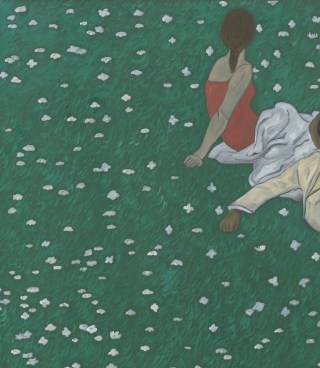Honor Titus is a former punk band member who, perhaps surprisingly, has developed a tranquil painting practice in recent years. The American artist’s works are often serene solo scenes that belie the adrenaline-filled rush of his twenties, as frontman for New York’s Cerebal Ballzy. In the last three years his profile as a painter has quickly risen, with industry affirmations from the likes of the legend Raymond Pettibon. He followed a debut 2020 show at Henry Taylor’s Los Angeles space with a 2021 solo at Timothy Taylor in New York and a 2022 exhibition at the latter’s London gallery.
“I was living quite a chaotic, outward life beforehand,” Titus tells me over the phone. “I think some of it is to do with growing up. I still wanted to create and express myself but I felt that I had to slow down and reinterpret how I was approaching not only my vocation, but my life.”
His paintings reflect this change. They often feel timeless, with vintage clothes and furniture pointing to no single decade, but certainly to the past. Technology is entirely absent from Titus’ images. His subjects don’t connect with mobile phones but with the world around them, gazing into the eyes of dancing partners, lounging in nature, or busying themselves at sports. There is a languid feel to his paintings that speak to the narrative worlds created by F. Scott Fitzgerald or the early 20th-century scenes of Edward Hopper. There is also a sense of loss in the works, a yearning for a past that no longer exists.
“I’m maybe from the last generation that would knock on doors unannounced or call the home phone and speak to a romantic interests’ parents,” he laughs. “These little nuances of life have changed. I can’t help but miss my youth in some ways. I also consume a lot of media from the past. I look at Studio 54, images of cafes in Paris in the 1940s, turn of the century French painters.”
Clothing takes a central role in Titus’ paintings. His characters all have a distinct sense of style. Shirt sleeves are rolled to the perfect length, hanging just above the elbow with a casual yet conscious elegance. The artist seems to revel in each fold of fabric, painting vintage sports clothes with the same sensitivity and beauty as silk gowns.
“The clothes are very considered,” he tells me. “There are little signifiers of humanity and devotion and I guess that’s what I’m looking for. It’s the same thing that makes a poem good to me, or a song danceable. It’s something well-constructed, well composed. It could be the cut of a man’s pants in the sixties, or a look in the woman’s eyes in the thirties. Perhaps a teenager outside of a school dance in the forties thar looks mischievous. It might be from a completely different time but I can relate to that mischief, I can relate to being fourteen.”
Music also plays its part in his works, though they are more likely to evoke the moody chill of jazz than the raw emotion of punk. Once he is painting a work, Titus tells me the piece is basically finished. The planning and influence of different melodies, stories or found images will happen before any paint is applies to the canvas. But he does have an electric relationship with sound in the studio. “I love listening to literature while I’m painting,” he says. “Often times I’ll ‘cheat’ the classics and listen to long novels that I can’t necessarily devote the time to reading. I listen to a lot of jazz and quite a bit of classical during the daytime in my studio. I think people would be surprised by my studio life and internal dialogue. Silence happens quite often too.”
He also attributes that much needed silence to his move from New York to Los Angeles, and to entering his thirties. “I think being young in downtown New York, there are so many personalities, ideas, colours. I look back at those punk years and think I just wanted to be heard. That’s what the aggressive, short, loud songs were about. I didn’t want to fall to the wayside. I now have more security and a richer dialogue with my internal self.”
Titus originally moved into painting after meeting and befriending Raymond Pettibon. “Raymond played a big part in me seeing what a studio practice looked like,” he tells me. “Of course, I’d heard of Black Flag [the rock band Pettibon famously created posters for], I knew that artwork, but I wasn’t necessarily familiar with his as an artist. One of the first things we really hit it off about was literature. He walked me through his personal library and showed me some rare Rimbaud that he had and some rare French writers. I think there’s a freedom within his art and he’s an insatiable worker. I think I also bring that to what I do.”
Looking through Titus’s oeuvre before we speak, I am most struck by the overriding peace in his works. There is a gentility to all of them, a sense of calm that feels almost meditative. “Wow, that’s quite the compliment,” he says. “I find peace, hopefully, through the creation. The transfer for me from music to painting was about peace. It’s interwoven into every painting.”
Interview with Honor Titus
Emily Steer, The Week, 6 April 2023

